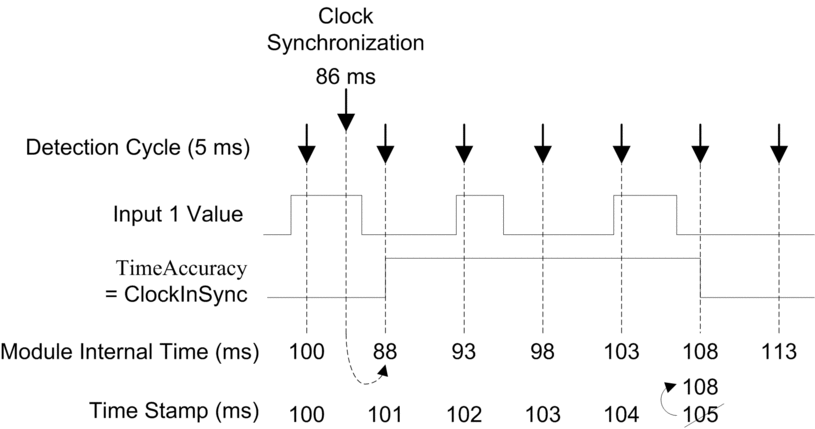Time Synchronization on System Start
On system start, the time stamping modules begin to
time stamp events without waiting for the initial time synchronization.
To signal that the first synchronization has not been done
yet to the SCADA server, the following parameters of TimeQuality are set to 1:
ClockNotSynchronizedClockFailure
Once the time stamping module time is synchronized, ClockNotSynchronized and ClockFailure parameters are set to 0 in TimeQuality.
Time Synchronization When the System Is Running
When the system is running, each time stamping module periodically synchronizes its clock with the external clock reference. On synchronization, 3 situations appear:
| Module internal time is equal to external clock time: | No change in module internal time. |
| Module internal time is delayed compared to external clock time: | Module internal time synchronizes with external clock time. |
| Module internal time is ahead of external clock time: | Module internal time synchronizes with external clock time in the following way:
NOTE: “Catch-up time”: the time required to synchronize
the time stamp value with the new internal time.
Synchronization mechanism until module internal time > last time stamp value (internal time cannot be accessed by the user):
|
The following figure illustrates the synchronization mechanism in a BMX CRA 312 10 module when the internal time is ahead of external clock time (5 ms detection cycle and 1 ms incrementation step):

The following table presents the SOE sequence shown in previous figure provided by a BMX CRA 312 10 time stamping module with 1 time stamped input:
Event |
Event Value |
TimeStamp (ms) |
Module Internal Time (ms) |
|
Comment |
|---|---|---|---|---|---|
CRA INPUT 1 (0 -> 1) |
1 |
100 |
100 |
Time Resolution = 1 ms |
|
No event |
N.A. |
N.A. |
86 |
N.A. |
External clock synchronization value received. |
CRA INPUT 1 (1 -> 0) |
0 |
101 |
88 |
|
Internal Time (n) <=Time Stamp (n-1) => Time Stamp (n) = Time Stamp (n-1) + 1 ms |
CRA INPUT 1 (0 -> 1) |
1 |
102 |
93 |
|
Internal Time (n) <= Time Stamp (n-1) => Time Stamp (n) = Time Stamp (n-1) + 1 ms |
CRA INPUT 1 (1 -> 0) |
0 |
103 |
98 |
|
Internal Time (n) <= Time Stamp (n-1) => Time Stamp (n) = Time Stamp (n-1) + 1 ms |
CRA INPUT 1 (0 -> 1) |
1 |
104 |
103 |
|
Internal Time (n) <= Time Stamp (n-1) => Time Stamp (n) = Time Stamp (n-1) + 1 ms |
CRA INPUT 1 (1 -> 0) |
0 |
108 |
108 |
Time Resolution = 1 ms |
Internal Time (n) > Time Stamp (n-1) => Time Stamp (n) = Internal Time (n) |
N.A. Not Applicable |
|||||
In this example: Catch-up time = (100 - 86) x 5 / (5 - 1). Catch-up time = 17.5 ms (around 4 detection cycles of 5 ms).
Event: Data available in Tag, Name and Message fields in AVEVA Plant SCADA SOE display.
Timestamp: Data available in Date and Time fields in AVEVA Plant SCADA SOE display.
TimeQualityAttributes: Data available in Quality and TSQuality fields in AVEVA Plant SCADA SOE display.
Time Synchronization Lost When the System Is Running
If the time synchronization is lost (no link with the external time reference), the time stamping module time stamps events with its internal time, based on the latest successful synchronization.
As in the initial start case, to manage that situation, CLOCK_NOT_SYNC parameter is set to 1 (and ClockNotSynchronized parameter is set to 1
in TimeQuality byte).
Once
the time stamping module time is synchronized, CLOCK_NOT_SYNC parameter is set to 0 (and ClockNotSynchronized parameter is set to 0
in TimeQuality byte).
CLOCK_NOT_SYNC parameter is different for a BMX ERT 1604
T and a BM• CRA 312 10 module.Time interval between the loss of time synchronization
and the setting of CLOCK_NOT_SYNC parameter:
for a BMX ERT 1604 T: 10 seconds (IRIG-B) or 10 minutes (DCF77).
for a BM• CRA 312 10: 3 seconds after the scheduled polling time.


